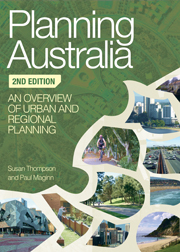Book contents
- Frontmatter
- Contents
- Contributors
- Figures and tables
- Discussion points and case studies
- Preface
- Acknowledgments
- Abbreviations
- Table of statutes
- Introduction
- Part I Frameworks
- Part II Key Issues
- 6 Planning and the natural environment
- 7 The metropolis
- 8 Planning for rural landscapes
- 9 Planning for regions
- 10 Planning for diverse communities
- 11 Aboriginal and Torres Strait Islander Australians
- 12 Community participation in planning
- 13 Urban design
- 14 Planning for heritage conservation and management
- 15 Transport planning
- 16 Healthy planning
- Conclusion: planning Australia into the future
- Index
- References
8 - Planning for rural landscapes
from Part II - Key Issues
- Frontmatter
- Contents
- Contributors
- Figures and tables
- Discussion points and case studies
- Preface
- Acknowledgments
- Abbreviations
- Table of statutes
- Introduction
- Part I Frameworks
- Part II Key Issues
- 6 Planning and the natural environment
- 7 The metropolis
- 8 Planning for rural landscapes
- 9 Planning for regions
- 10 Planning for diverse communities
- 11 Aboriginal and Torres Strait Islander Australians
- 12 Community participation in planning
- 13 Urban design
- 14 Planning for heritage conservation and management
- 15 Transport planning
- 16 Healthy planning
- Conclusion: planning Australia into the future
- Index
- References
Summary
Key terms: rural land; rural character; peri-urban; rural land-use conflict; agriculture; rural lifestyle; rural residential; sustainability; zoning; food security.
Land available for agriculture is declining across the globe as expanding populations inhabit fertile land that could otherwise be devoted to food production. Although this problem is not as severe in Australia as it is in countries with a smaller land mass, urban encroachment is nonetheless affecting the capacity of Australian producers to grow food in the areas in which it is demanded, which in turn affects its quality and affordability. Competition for fertile land from mining and biofuels also threatens to reduce Australia’s productive capacity. Australian governments need to give serious consideration to mechanisms for protecting our most fertile agricultural land from alternative uses in the interests of our long term productive capacity and food security. (Senate Select Committee 2010, pp. 20–1)
Planning rural regions combines natural resource management with land-use planning in a manner that depends on their location and resource endowment. Most of rural Australia is remote from significant urban settlements and has low population density. For these regions, the dominant consideration is ensuring sustainable production through appropriate natural resource management, but the normal land-use planning systems are of little relevance because they are biased towards urban areas (Farrier et al. 1998).
Accordingly, this chapter concentrates on planning for and management of rural land use in ‘peri-urban’ or fringe metropolitan and coastal areas, where the impact of urban settlements or strong population growth raises several common issues and where land-use planning systems are the chief means of managing growth. However, while concentrating on the coastal and fringe metropolitan areas, the approach is just as relevant to inland regional Australia because of the growing importance of natural resource management everywhere, and its increasing integration with land-use planning measures (Bunker, Houston & Hutchings 2007)
- Type
- Chapter
- Information
- Planning AustraliaAn Overview of Urban and Regional Planning, pp. 180 - 203Publisher: Cambridge University PressPrint publication year: 2012
References
- 3
- Cited by



